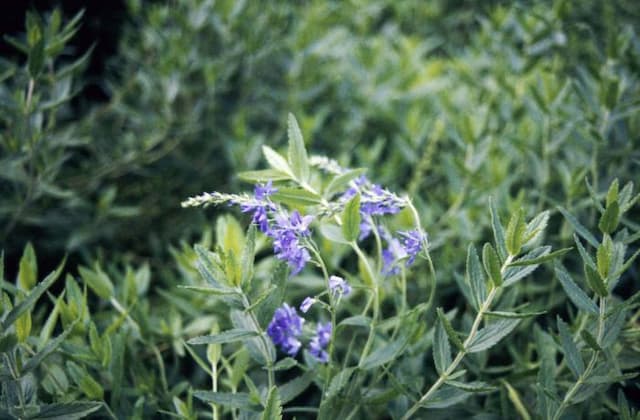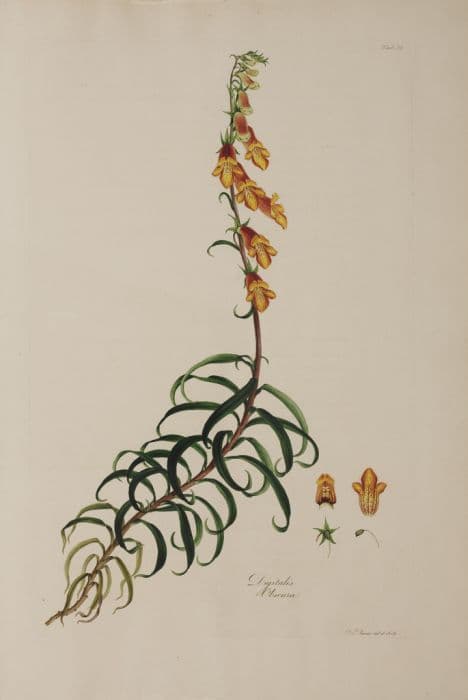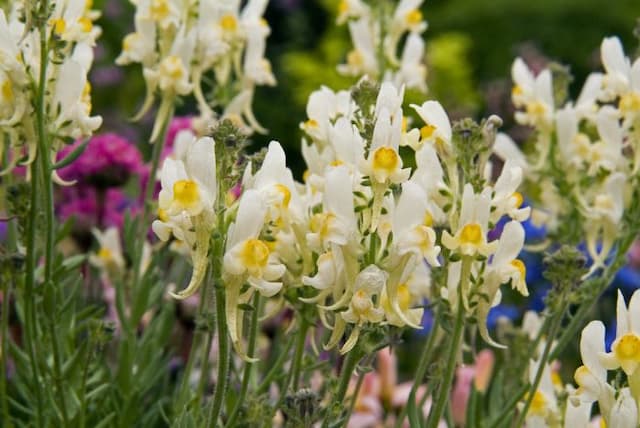Foxglove Digitalis purpurea Foxy Group

ABOUT
Commonly known as Foxglove, the Foxy Group is renowned for its eye-catching and somewhat dramatic appearance. The plant is characterized by an upright habit with a central stem from which large, bold leaves emanate. These leaves are typically fuzzy with a veiny texture, colored a rich green that sets the stage for the plant's most striking feature: its flowers. The flowers of the Foxglove are spectacular, shaped like elongated bells or thimbles that dangle gracefully from the stem. They are arranged in a dense raceme, giving the appearance of an extended spike that blooms sequentially from the bottom up. Each individual flower has an exquisite pattern, usually spotted or mottled on the inside, which adds to their intricate look. The color palette ranges from purples and pinks to whites and creams, and sometimes the flowers can display a beautiful gradual transition from a pale throat to deeper hued petal tips. Additionally, it's common for the majestic flowering spikes to attract a variety of pollinators, including bees, who are enticed by the rich nectar and the striking flower display. The plant's overall appearance, with its combination of lush foliage and vivid, bell-shaped flowers, makes it a popular choice for gardeners aiming to add vertical interest and a touch of drama to their garden settings.
About this plant
 Names
NamesFamily
Plantaginaceae
Synonyms
Common Foxglove, Purple Foxglove, Lady's Glove
Common names
Digitalis purpurea var. gyspergerae, Digitalis macrostigma, Digitalis purpurea var. toletana, Digitalis purpurea var. amandiana.
 Characteristics
CharacteristicsLife cycle
Biennials
Foliage type
Deciduous
Color of leaves
Green
Flower color
Mixed
Height
2-3 feet (0.6-0.9 meters)
Spread
1-2 feet (0.3-0.6 meters)
Plant type
Herb
Hardiness zones
4
Native area
Europe
Benefits
 General Benefits
General Benefits- Attracts pollinators: The plant is known for its ability to attract bees, butterflies, and hummingbirds, which are crucial for pollination in gardens.
- Aesthetic appeal: With its tall spires of bell-shaped flowers in colors ranging from purple to pink, white, and cream, Foxglove adds vertical interest and beauty to any garden.
- Versatile in landscaping: Foxglove can be used in various parts of gardens, including borders, woodland plantings, and as an accent plant in perennial gardens.
- Shade tolerance: As a woodland plant, Foxglove performs well in partial shade, making it a great option for garden spots that don't receive full sunlight.
- Wildlife habitat: The dense foliage and flowers provide shelter and nesting spots for various small wildlife, and it's a food source for some moth and butterfly larvae.
 Medical Properties
Medical Properties- Cardiac glycosides: The leaves of Digitalis purpurea contain cardiac glycosides such as digoxin and digitoxin, which can increase the force of heart contractions and are used to treat certain heart conditions.
- Heart rate regulation: It has historically been used in the treatment of heart rate disorders such as atrial fibrillation and atrial flutter by controlling the rate at which the heart beats.
- Heart failure treatment: Digitalis purpurea extracts can be used to improve symptoms of heart failure by increasing the efficiency of the heart and reducing symptoms such as shortness of breath and swelling.
 Air-purifying Qualities
Air-purifying QualitiesThis plant is not specifically known for air purifying qualities.
 Other Uses
Other Uses- Dye Production: Digitalis purpurea's flowers and leaves can be used to create a range of dyes for textiles, often resulting in soft green to yellow hues.
- Fairy Gardens: Due to its whimsical spikes of bell-shaped flowers, it is often integrated into fairy garden designs for its enchanting appearance.
- Botanical Illustration: The striking look of Digitalis purpurea makes it a favorite subject for botanical artists and illustrators.
- Photography: With its tall, colorful spires, Foxglove is a popular choice for garden photographers and is often featured in gardening magazines.
- Educational Use: The plant is used in educational settings to teach about plant biology, particularly in discussions about pollination and the specific adaptations of its flowers to bumblebees.
- Drama and Film Props: As a visually distinct plant, Foxglove is occasionally used as a prop in theater productions and films to create a specific atmosphere or setting.
- Culinary Decoration: While the plant is toxic and not edible, it can be used as a decorative element on dishes in high-end restaurants, provided it does not come into contact with the food.
- Flower Arranging: Although toxic, the tall and impressive flower spikes of Digitalis purpurea are sometimes used in large, carefully handled floral arrangements.
- Victorian Language of Flowers: In historical contexts, Foxglove is used to convey a message of insincerity or a lack of trust, following the Victorian language of flowers.
- Wildlife Gardens: Its nectar-rich flowers are known to attract bees, butterflies, and hummingbirds, making it a useful plant for wildlife and pollinator gardens.
Interesting Facts
 Feng Shui
Feng ShuiThe Foxglove is not used in Feng Shui practice.
 Zodiac Sign Compitability
Zodiac Sign CompitabilityThe Foxglove is not used in astrology practice.
 Plant Symbolism
Plant Symbolism- Healing: Digitalis purpurea, commonly known as Foxglove, is well-known for its medicinal properties, particularly for its role in creating heart medications, symbolizing the power of healing.
- Protection: In folklore, Foxglove was believed to protect homes and gardens from evil spirits, symbolizing protection and safety.
- Magic and Enchantment: With its bell-shaped flowers, Foxglove is often associated with the fairy realm and magical stories, symbolizing a bridge to the magical and the enchanting.
- Inspiration: The beauty and prominence of Foxglove flowers have been associated with inspiration, symbolizing the ability to provoke creativity and artistic expression.
- Toxicity: Despite its beauty, the Foxglove is toxic if ingested. Thus, it symbolizes both the dual nature of beauty—being attractive yet dangerous—and a reminder of the fine line between medicine and poison.
 Water
WaterThe common name for Digitalis purpurea Foxy Group is Foxglove. Foxglove should be watered deeply but infrequently to encourage deeper root growth. Typically, watering once a week with 1 to 1.5 inches of water is sufficient, but this can vary depending on climate and soil conditions. During hot and dry periods, increase watering to twice a week. Always check the soil moisture before watering; the soil should be moist but not waterlogged. In wetter climates, reduce watering to prevent root rot.
 Light
LightFoxglove thrives in partial shade to full sun environments. The ideal spot for Foxglove would provide morning sunlight and afternoon shade, especially in areas with hot summers. Avoid deep shade as it can lead to poor flowering and weak growth. If planted in full sun, regular watering becomes particularly important to prevent stress on the plant.
 Temperature
TemperatureFoxglove grows well in a wide range of temperatures but performs best when daytime temperatures are between 60 and 80 degrees Fahrenheit. They can survive minimum temperatures down to 40 degrees Fahrenheit but may not thrive below this point. Extreme heat above 90 degrees Fahrenheit can stress the plants, especially if not adequately watered.
 Pruning
PruningPrune Foxglove to encourage a second bloom and to maintain a tidy appearance. After the first bloom, cut back the spent flower spikes to just above the basal leaves. This can stimulate a second, smaller flush of flowers later in the season. The best time for pruning is late summer after flowering has completed.
 Cleaning
CleaningAs needed
 Soil
SoilFoxglove prefers well-draining soil rich in organic matter with a pH of 5.5 to 6.5. A mix could be garden soil, compost, and peat moss.
 Repotting
RepottingFoxgloves are biennials or short-lived perennials and do not often require repotting; plant them out where they can grow undisturbed.
 Humidity & Misting
Humidity & MistingFoxglove thrives in average humidity levels; they do not require special humidity conditions outside of normal garden environments.
 Suitable locations
Suitable locationsIndoor
Provide bright, indirect light and cool temperatures.
Outdoor
Plant in partial shade with moist, well-draining soil.
Hardiness zone
4-9 USDA.
 Life cycle
Life cycleThe life of Foxglove (Digitalis purpurea Foxy Group) begins as seeds, which require cold stratification to break dormancy. Once conditions are favorable, the seeds germinate and the plant starts its vegetative growth, developing a basal rosette of leaves in the first year. After establishing a strong root system, Foxglove enters its second year of growth, during which it produces a tall flowering spike. The flowering stage occurs in early summer of the second year, where tubular, bell-shaped flowers that range in color from purple to white appear, attracting bees and other pollinators. Following pollination, the plant sets seed; the flowers give way to seed pods that release numerous small seeds. At the end of its life cycle, which is typically biennial, the Foxglove plant dies after seed dispersal, relying on its progeny to continue the species.
 Propogation
PropogationPropogation time
Spring-Early Summer
Propogation: Foxglove (Digitalis purpurea Foxy Group) is commonly propagated by seeds, which is the most popular method for this plant. Sowing seeds can begin in late spring to early summer, after the threat of frost has passed, usually between May and June in the Northern Hemisphere. To propagate, sprinkle the small seeds lightly on top of a well-draining seed starting mix, because they need light to germinate, and lightly press them into the soil without covering them. Maintain consistent moisture and keep the soil temperature around 65 to 70 degrees Fahrenheit (18 to 21 degrees Celsius). Germination usually occurs within two to three weeks. Once seedlings are large enough to handle and have a pair of true leaves, they can be transplanted into individual pots or spaced out in the garden.








![Hebe [Garden Beauty Blue]](/_next/image?url=https%3A%2F%2Fplants-admin.emdemapps.com%2Fimages%2Fplants%2F%2Fimages%2F604b58cbcb4e2.png&w=640&q=75)
